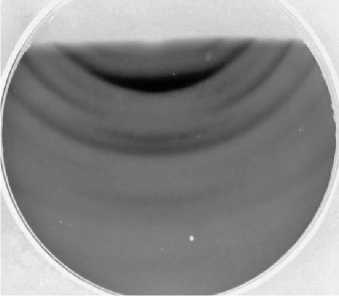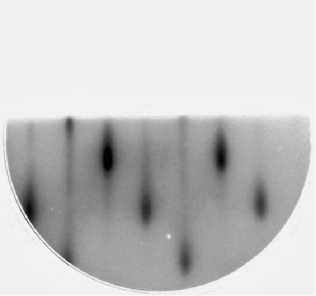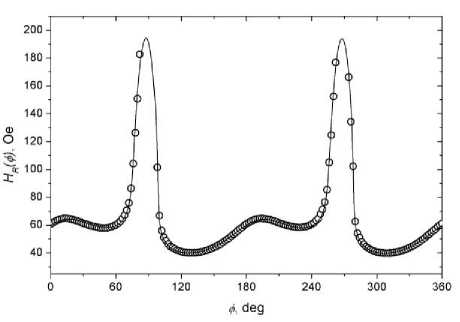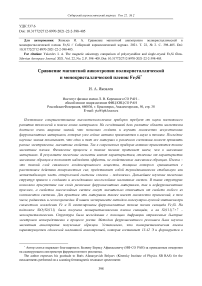The magnetic anisotropy comparison of polycrystalline and single-crystal Fe3Si films
Автор: Yakovlev I. A.
Журнал: Siberian Aerospace Journal @vestnik-sibsau-en
Рубрика: Technological processes and material science
Статья в выпуске: 2 vol.22, 2021 года.
Бесплатный доступ
High-tech devices improvement requires development of technology and search for new materials from science. Currently, the development of the magnetism research field has reached a very broad knowledge, making it possible to create and study a variety of artificial ferromagnetic materials, which are already actively used in science and technology. The latest scientific knowledge shows that the same material in different states can exhibit different electrical and magnetic properties. Thus, thin magnetic films are actively used in modern devices. Physical processes in thin films proceed differently than in bulk materials. As a result, the film elements have characteristics that differ from those of bulk samples and make it possible to observe effects that are not characteristic of bulk samples. A film is a thin layer of a bound condensed substance, the thickness of which is compared with the distance of surface forces action; it is a thermodynamically stable or metastable part of a heterogeneous film-substrate system. Further researsh of film structures led to the creation and study of multilayer magnetic systems. In such structures, the presence of both various ferromagnetic materials layers and non-ferromagnetic interlayers is possible, and the multilayer systems properties can differ significantly from the properties of any system components. These materials also have many practical applications, including radio communications and geological exploration. In our experiment, ferromagnetic thin films of Fe3Si silicide were synthesized by molecular beam epitaxy with co-deposition of Fe and Si. A polycrystalline silicide film was obtained on a SiO2/Si(111) substrate, and a single-crystal film - on Si(111)7×7. The structure was investigated using the diffraction of reflected fast electrons directly during the growth process. The magnetic anisotropy of the obtained samples was studied applying the method of ferromagnetic resonance. It was found that the polycrystalline film is characterized by uniaxial magnetic anisotropy, which is 13.42 Oe and is formed as a result of “oblique” deposition, whereas the magnetic anisotropy for a single-crystal Fe3Si film is formed to a greater extent by internal magnetocrystalline forces.
Magnetic anisotropy, ferromagnetic films, Fe3Si, molecular beam epitaxy.
Короткий адрес: https://sciup.org/148321814
IDR: 148321814 | УДК: 537.6 | DOI: 10.31772/2712-8970-2021-22-2-398-405
Текст научной статьи The magnetic anisotropy comparison of polycrystalline and single-crystal Fe3Si films
One of the key issues for realizing spintronic applications is the production of high-quality epitaxial ferromagnets with high spin polarization on semiconductor substrates. Hybrid structures consisting of alternating metallic and semiconducting layers are of great interest for modern spintronic devices. Important aspects of the layered material system applicability are stable magnetism in close proximity to interfaces and a suitable states density at the Fermi level, which, however, are highly dependent on the interface structure. Spin polarization indicates its quality for transport devices.
Iron-based systems are also of interest in the scientific community. Spin injection of more than 30% was measured for Fe / GaAs (001) [1], as well as 10 % for Fe 3 Si / GaAs (001) [2; 3]. Since the atomically clean GaAs (110) surface is not reconstructed [4], epitaxial growth is possible for both Fe and quasi-Geusler Fe 3 Si, for which the lattice mismatch amounts to only 0.1 % [5].
Silicide Fe 3 Si is a ferromagnetic material that can be a promising candidate for the injection of spin-polarized electrons from a ferromagnet into a semiconductor [2]. For Fe 3 Si / GaAs heterostructures, the structural, transport, and magnetic properties have been studied [6–9]. For epitaxial Fe 3 Si films grown on GaAs (001) by MBE, the magnetotransport properties were studied mainly by applying a current along the hard magnetization axis, i.e, along the [110] crystallographic axis, which is the direction of easy cleavage for GaAs (100) [10 ].
Numerous studies show that depending on the crystal structure of the interface films in layers, the same material has different properties, which determines their future use, as well as the development of technologies for their synthesis and processing. The anisotropic magnetoresistance for Fe 3 Si showed that the resistivity in a field perpendicular to the current was greater than the resistivity in a field parallel to the current. It is known that in single crystals the direction of the current and magnetization relative to the crystal axes affects the behavior of the magnetoresistance [11].
Crystals orientation in thin magnetic films is closely related to both their physical and magnetic properties. Textured magnetic materials often exhibit much better characteristics such as easy magnetization, high magnetostriction and excellent squareness in the B – H magnetization loop, flux density plot, B, for various magnetic field strengths, H [12–15]. This information makes it possible to create microelectronic devices, including radio communications, with higher accuracy and sensitivity for practical use.
In our work, we investigated the magnetic properties, including the in-plane magnetic anisotropy, for Fe 3 Si silicide films with polycrystalline and single-crystal structures.
Experiment
Polycrystalline and epitaxial Fe 3 Si films were obtained applying molecular beam epitaxy with the joint deposition of iron and silicon. For the films obtained, the magnetic anisotropy was studied using the method of ferromagnetic resonance (FMR), the contributions of unidirectional, uniaxial, cubic, and hexagonal anisotropies to the resulting value were determined, as well as the high-frequency (microwave) magnetic characteristics of all the films under study: the width of the ferromagnetic resonance line, the effective saturation magnetization, and the values of ferromagnetic resonance for a given pumping frequency.
The synthesis of the samples was carried out in an "Anagara" ultrahigh-vacuum molecular-beam epitaxy unit, with the base vacuum of 1.3 × 10–8 Pa. The deposition was carried out by the method of thermal evaporation from effusion Knudsen cells from two sources simultaneously, the so-called coprecipitation, of iron and silicon in atomic proportions
Fe: Si = 3:1. The film formation process was monitored by the method of high-energy reflected electron diffraction (RHEED).
Crystalline structure
In the course of the experiment, a polycrystalline Fe 3 Si film with a thickness of 40 nm was obtained. It was synthesized at room temperature on a Si (111) substrate coated with a SiO 2 oxide layer about 1.5 nm thick. Fig. 1 shows a RHEED pattern for this structure.

Рис. 1. Картина ДОБЭ от пленки Fe 3 Si на SiO 2 / Si(111)
Fig. 1. RHEED pattern on Fe 3 Si/SiO 2 / Si(111)
The obtained diffraction pattern contains reflections in the form of concentric Debye rings, as well as sectors of the rings. This geometry of the diffraction pattern corresponds to a polycrystalline structure with a certain texture.
Fig. 2 shows the diffraction pattern of reflected fast electrons from Fe 3 Si films 40 nm thick, obtained on a 7 × 7 Si (111) substrate at room temperature.

Рис. 2. Картина ДОБЭ от пленки Fe 3 Si/Si(111)7×7
Fig. 2. RHEED pattern on Fe 3 Si/Si(111)7×7
This diffraction pattern contains reflections in the form of points elongated in the vertical direction. This geometry of the pattern corresponds to a single-crystal structure of a film with an island surface morphology. The analysis of the diffraction data also shows that Fe 3 Si films on Si (111) 7 × 7 are formed epitaxially.
Study of magnetic anisotropy
For both films, the magnetic anisotropy was investigated by the method of ferromagnetic resonance. Fig. 3 shows the angular dependences of the ferromagnetic resonance field, obtained on a scanning ferromagnetic resonance spectrometer at the pump frequency 3.329 GHz [16].

а
Рис. 3. Угловые зависимости поля ферромагнитного резонанса для поликристаллической пленки Fe 3 Si ( а ); монокристаллической пленки Fe 3 Si ( б ) (круг – экспериментальные данные, линия – расчетная кривая)

б
Fig. 3. The angular dependences of the ferromagnetic resonance field for polycrystalline Fe 3 Si film ( a );
a single-crystal Fe 3 Si film ( b ) (circle – experimental data, line – calculated curve)
According to this dependence, based on the phenomenological model, the following characteristics for the obtained film were calculated applying the iterative technique [17] (Table 1): effective saturation magnetization M S , unidirectional anisotropy field H k1 , uniaxial anisotropy field H k2 , and cubic anisotropy field H k4 . Based on the ferromagnetic resonance data the FMR line width in the direction of the easy magnetization axis ΔH ema was also determined (Table 1).
Magnetic characteristics of films Fe 3 Si
Table 1
|
Fe 3 Si/SiO 2 /Si(111) |
Fe 3 Si/Si(111)7×7 |
|
|
Polycrystalline |
Single-crystal |
|
|
M S, Hs |
1235,5 |
1227,2 |
|
H k1 , Oe |
0,48 |
0,17 |
|
H k2 , Oe |
13,42 |
73,16 |
|
H k4 , Oe |
0,23 |
310,58 |
|
Δ H ОЛН , Oe |
33,5 |
7,7 |
Based on the data analysis, it was found that the polycrystalline film is to a greater extent characterized only by uniaxial anisotropy, which is approximately 28 times higher than other components. The formation of predominantly uniaxial anisotropy is most likely caused by the deposition of the material at the angle to the substrate surface, the so-called "oblique" deposition [18].
For a single-crystal Fe 3 Si film on Si (111) 7 × 7, the same magnetic characteristics as for polycrystalline samples were determined (Table 1), but according to the method [19] adapted for single-crystal structures.
From the data obtained (Table 1), it can be seen that the single-crystal film is dominated by the cubic magnetic anisotropy H k4 , which is more than four times greater than the uniaxial component H k2 . This fact shows and justifies our film to posess a single-crystal structure. In turn, the uniaxial anisotropy for a singlecrystal Fe 3 Si is more than 5 times stronger than for a polycrystalline sample. To determine the exact nature of such differences, additional studies of the structural and magnetic properties of all elements of our sample are required. However, most likely, this is caused by the several factors: misorientation of the substrate surface, "oblique" deposition, and internal forces in a single crystal.
Conclusion
Poly- and single-crystal Fe 3 Si silicide films on Si (111) substrates were obtained by molecular beam epitaxy. The magnetic anisotropy was studied applying the method of ferromagnetic resonance. It was found that the polycrystalline film is characterized by uniaxial magnetic anisotropy, which is 13.42 Oe and is formed as a result of "oblique" deposition, while the magnetic anisotropy for a single-crystal Fe 3 Si film is formed mostly by internal magnetocrystalline forces. The presented results show that by varying the crystal structure of one material, it is possible to change its magnetic properties and, therefore, employ in various applications, for example, in spintronic devices or sensors of weak magnetic fields.
Список литературы The magnetic anisotropy comparison of polycrystalline and single-crystal Fe3Si films
- Li C. H., Kioseoglou G., J. van 't Erve O. M., Petrou A. Spin injection across (110) interfaces: Fe/GaAs(110) spin-light-emitting diodes. Applied Physics Letters. 2004, Vol. 85, No. 9, P. 1544–1548.
- Kawaharazuka A., Ramsteiner M., Herfort J., Schonherr H.-P. Spin injection from Fe3Si into GaAs. Applied Physics Letters. 2004, Vol. 85, No. 16, P. 3492–3494.
- Herper H. C., Entel P. Interface structure and magnetism of Fe3Si/GaAs(110) multilayers: An ab-initio study. Philosophical Magazine. 2008, Vol. 88, No. 18-20, P. 2699–2707.
- Qian G.-X., Martin R., Chadi J. First-principles calculations of atomic and electronic structure of the GaAs(110) surface. Physical review. B (Condensed matter). 1988, Vol. 37, No. 3, P. 1303–1307.
- Grunebohm A., Siewert M., Herper H. C., Gruner M. E., Entel P. A comparative study of (Fe, Fe3Si)/GaAs and Heusler/MgO for spintronics applications. Journal of Physics: Conference Series. 2010, Vol. 200, P. 072038.
- Liou S. H., Malhotra S. S., Shen J. X., Hong M., Kwo J., Chen H.-C., Mannaerts J. P. Magnetic properties of epitaxial single crystal ultrathin Fe3Si films on GaAs (001). Journal of Applied Physics. 1993, Vol. 73, No. 10, P. 6766–6768.
- Vinzelberg H., Schumann J., Elefant D., Arushanov E., Schmidt O. G. Transport and magnetic properties of Fe3Si epitaxial films. Journal of Applied Physics. 2008, Vol. 104, No. 9, P. 093707–093707.
- Bowen M., Friedland K.-J., Herfort J., Schönherr H.-P., Ploog K. H. Order-driven contribution to the planar Hall effect in Fe3Si thin films. Physical Review B. 2005, Vol. 71, No. 17, P.172401.
- Zakeri K., Hashemifar S. J., Lindner J., Barsukov I., Meckenstock R., Kratzer P., Frait Z., Farle M. Spin and orbital magnetism in ordered binary Heusler structures: Theory versus experiment. Physical Review B. 2008, Vol. 77, No. 10, P. 104430.
- Ionescu A., Trypiniotis T., Garcia-Miquel H., Vickers M. E., Dalgliesh R. M., Langridge S., Bugoslavsky Y., Miyoshi Y., Cohen L. F. Structural, magnetic, electronic, and spin transport properties of epitaxial Fe3Si/GaAs(001). Physical Review B. 2005, Vol. 71, No. 9, P. 094401.
- Hung H. Y., Huang S. Y., Chang P., Lin W. C., Liu Y. C., Lee S. F., Hong M., Kwo J.Strong crystal anisotropy of magneto-transport property in Fe3Si epitaxial film. Journal of Crystal Growth. 2011, Vol. 323, P. 372–375.
- Hong J. Thickness-dependent magnetic anisotropy in ultrathin Fe∕Co∕Cu(001) films. Physical Review. B.(Condensed matter). 2006, Vol. 74, P.172408
- Arai K. I., Ohoka Y., Wakui Y. [Preparation and magnetic properties of anodic oxide magnetic films]. Electronics and Communications in Japan. (Part II Electronics). 1989, Vol. 72, No. 5, P. 81–88.
- Liu X., Shiozaki Y., Morisako A. Magnetization reversal mechanism of ultra thin Nd2Fe14B films with perpendicular magnetic anisotropy. Journal of Applied Physics. 2008, Vol. 103, P. 07E104.
- Park S. J., Liu C.-H., Kim H. S., Park N. J., Jin S., Han J. H. Texture and magnetic properties of Fe thin films fabricated by field-sputtering vs field-annealing. Thin Solid Films. 2015, Vol. 594, P. 178–183.
- Belyaev B. A., Voloshin A. S., Izotov A. V. et al. Diagnostika tonkoplenochnykh struktur metodom ferromagnitnogo rezonansa : uchebnoe posobie [Thin-film structures investigation by the ferromagnetic resonance: a tutorial]. Krasnoyarsk, SiberianFederalUniversity, 2011, 104 p.
- Belyaev B. A., Izotov A. V., Leksikov A. A. Magnetic imaging in thin magnetic films by local spectrometer of ferromagnetic resonance. IEEE Sensors Journal. 2005, Vol. 5, No. 2, P. 260–267.
- Chi C.-S., Wang B.-Y., Pong W.-F., Ho T.-Y., Tsai C.-J., Lo F.-Y., Chern M.-Y., Lin W.-C. Uniaxial magnetic anisotropy in Pd/Fe bilayers on Al2O3 (0001) induced by oblique deposition. Journal of Applied Physics. 2012, Vol. 111, P. 123918.
- Belyaev B. A., Izotov A. V. FMR Study of the anisotropic properties of an epitaxial Fe3Si film on a Si(111) Vicinal Surface. JETPLetters. 2016, Vol. 103, No. 1, P. 41–45.


